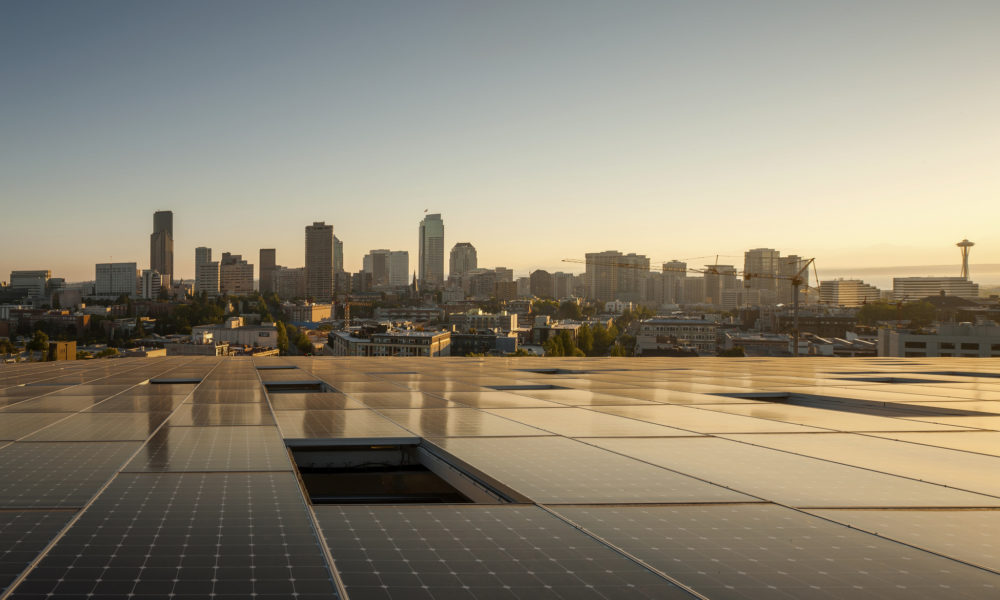The following is an excerpt from The Power of Zero: Learning from the World’s Leading Net Zero Energy Buildings by Brad Liljequist, our former Zero Energy Director at the International Living Future Institute. Get 30 percent off The Power of Zero from Ecotone Publishing using the code POZ30.
The International Living Future Institute defines Net Zero Energy (NZE) as “One hundred percent of the project’s energy needs being supplied by on-site renewable energy on a net annual basis.” In one simple, elegant sentence, a radical agenda for eliminating carbon dioxide emissions and use of combustion fuels within the built environment is set in place. In short: generate what you use. With this crisp idea, an array of powerful forces and concepts are brought to bear on some of our time’s most challenging problems.
Restated in more basic terms, Net Zero Energy buildings and communities generate as much energy as they use over the course of the year. The significant majority of NZE buildings are connected to the grid, with a meter that spins backwards and forwards: when the building is generating more than it uses it builds a surplus, and when it uses more than it generates, it draws from that surplus. At the end of the year, at a minimum it nets to zero use, or potentially is net positive. In practice, NZE buildings have to significantly lower the energy use from typical consumption — usually a 60- 80 percent reduction. On-site energy generation offsets the remaining use.
Net zero energy is such a radical and powerful concept because it is one of the key solutions to carbon neutrality and the elimination of fossil fuel use. If we apply favorite Institute questions of “What is the end game?,” and, “What if everyone did it?” to net zero energy, the end result would be massively positive. By sector, energy use in buildings is the largest single contributor to our carbon footprint — roughly 40 percent, depending on the estimate. If all current buildings were retrofitted to be net zero energy, and all new construction was built to a net zero standard, society’s collective carbon footprint would be reduced by that amount.
The Power of Zero is dedicated to practical, real examples of these buildings in a range of types, sizes, and places which achieve net zero energy usage. The existence of these projects means that net zero energy is a real, viable solution to what is likely the most significant threat to global stability currently in existence, on par with the threat of nuclear proliferation. Remaking our communities to be net zero energy is more than a neat exercise in efficiency. It is a moral imperative to protect those people most impacted by climate change and ocean acidification — those in the developing world and future generations. It eliminates one of the major drivers of military action (acquisition and protection of energy supplies) and degradation of local wilderness in the form of extraction impacts.
Within the framework of the International Living Future Institute’s thinking about human development and living in restorative harmony with the Earth, net zero energy stands as a gateway. Energy in all its forms is a key component of life; living in a way that draws vitality from within, instead of exchanging resources from others without positive return, is the way of nature. To our peril much of historic Western development has ignored this pattern of synergistic exchange, now to our peril. Net zero energy is the first opening into a new way of approaching what we make and dwell in, asking the question: How do our actions add to rather than subtract from energy supplies? Net positive energy, at its heart, is a biomimetic reflection of energy flows within nature.
In less philosophical but more practical, metaphoric terms, net zero energy represents old time, traditional values.
Living within your means
One of the most conservative values is to live in a way that does not exceed what you have. You do not eat your seed corn, and you take responsibility for yourself and family.
Thou shalt not steal
The unfortunate reality is that many of our resources have been obtained through power relationships that exceed a just exchange between the recipients and givers. Perhaps most compellingly, it is clear at this point that we are taking our descendants’ heritage from them, as they will bear the brunt of our irresponsibility in energy use and its impacts.
A penny saved is a penny earned
Our grandparents’ generation knew the value of simply using less. Net zero energy buildings and communities squeeze out every watt of savings possible. These buildings are not just resilient in their interaction with the Earth, but also in their long term basic demands of operating costs, providing an essentially conservative financial platform of living.
Reap the harvest
A foundational concept of human civilization is that we organize and systematize the gathering of the fruits of the Earth. For millennia that idea has primarily referred to a harvest of food. With new technologies and paradigms, it also can mean harvesting the energy provided by the Earth — the sun, wind (really solar energy), and tides.
Mottainai
Derived from an old Shinto concept that material objects have souls, this Japanese word embodies meanings of both wastefulness and irreverence. More recently, Kenyan Nobel Peace Prize winner Wangari Matthai sought to popularize the term internationally as a way to place a sense of the sacred on our thoughtful use of resources.
Net zero energy is also a very compelling concept to the general public, which crystalizes core needs of dramatic energy reduction and renewable energy generation into one simple, easy-to-understand idea. While it can be very challenging to excite the average person about the sometimes arcane world of energy efficiency, net zero energy has a demonstrated ability to inspire and involve people. NZE brings forward a can-do spirit which combines the best of applied technology and design, Buck Rogers, and big jumps forward. It is also an accessible, inspiring response to people beleaguered by a sense of hopelessness around larger energy use and climate problems.
Net zero energy buildings represent the beginning of a new era of innovation within the world of buildings. Amazingly, homes in much of the world are still built the way they were one hundred years ago. Within North America, balloon framing pioneered in the 1800s is still the standard. It is as if we still drove Ford Model T’s instead of electric vehicles, or used mechanical adding machines instead of computers. In most other sectors, the performance characteristics of the desired object tend to drive technological development, while in the building sector, the technologies have tended to define the design. We hopefully stand at the beginning of a new era of building design evolution, which reflects a whole array of human and environmental needs, only one of which includes eliminating the energy footprint of the built environment.
A key component of innovation to achieve net zero energy performance is a deep drive towards designing with nature, the laws of physics, and biomimetics. Net zero energy buildings take advantage of diurnal temperature swings, and available naturally stored thermal energy, capturing and retaining what is needed to serve the building. The gift of the sun, from which all life springs, is fully embraced, through daylight, heat, wind, and photons. Many of the key technologies used in net zero energy buildings respond to natural phenomena, such as evaporative cooling, stack effect, the ideal gas law, and gas/liquid/solid phase changes. Some of these phenomena are described in more detail in section three, below.
As part of its net zero and net positive energy requirements, the Institute prohibits the use of on-site combustion. There are a number of reasons for this prohibition. Typically, building related combustion involves so-called “natural” gas, which adds CO2 to the atmosphere and oceans. Eliminating its use is a major priority of the ILFI. Extensive use of woody biomass removes critical material from natural cycles, and in many cases accelerates climate change by speeding up the slower release of CO2 through decay. Biogas supplies can prove transitory, and easily default to natural gas. Depending on the type of combustion, local air quality impacts can be significant. While it is recognized that most net zero energy buildings are connected to a grid which is reliant on the larger energy grid, of which natural gas and coal burning power plants currently play a significant role, the Institute’s end goal is a fully renewable energy grid which includes the complete elimination of combustion, particularly of fossil fuels. Impacts of combustion are discussed further in the section below, and the end state vision of the grid is discussed in Part IV.
Finally, in 2013, the Institute launched the Net Positive conference in San Francisco, California, indicating a conceptual shift in net zero energy. Version 3.0 of the Living Building Challenge evolved the Energy Petal to require 105 percent of a building’s energy use to be offset by on-site generation, rather than 100 percent. At the same time, the Institute has strengthened and extended its Net Zero Energy Building certification. In terms of actual change in energy generation, the amounts are relatively modest. In concept, however, the evolution of net zero to net positive is significant: nature does not do zero. Natural systems tend to be fecund and generous, providing a bounty beyond what the individual needs. Net positive energy is a libation of abundance, a ray of goodwill and intention to our neighbors and the future.





